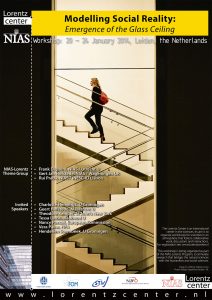NIAS-Lorentz Theme Group 2013/14: “Modelling Social Reality: Emergence of the Glass Ceiling”
The very first NIAS-Lorentz Theme Group Modelling Social Reality: Emergence of the Glass Ceiling explores gender roles through social simulation. The group members will carry out their intensive interdisciplinary collaboration project from 1 September 2013 until 31 January 2014.
Research Project
Why, despite the stunning changes around us, do some things in society change so little? Apparently societies have ways to maintain social structure despite, or even through, changes. This theme group takes the glass ceiling for women as an example. This phenomenon exists in all societies, albeit in different forms. Our means is agent-based modelling, which allows to re-play society in computer models, \u201cgrow it to show it. In this study we shall make agent-based models of groups of children. We’ll design the children using development psychology, sociology, and cultural psychology, and see what happens when we let them play.
Rui Prada works on social emotions in particular, such as pride and shame. Gert Jan Hofstede concentrates on how patterns can emerge from interactions without being imposed from above, for instance, who’s boss in a group. Frank Dignum focuses on how patterns can become norms, for instance norms about what roles are appropriate for girls and boys.
Theme Group Members
Frank Dignum, Utrecht University
Gert Jan Hofstede (coordinator), Wageningen University
Rui Prada , Technical University of Lisbon



Workshop
The workshop Modelling Social Reality: Emergence of the Glass Ceiling was held from 20 January through 24 January 2014, and took a foundational step forward by developing a generic model of social reality to be used in simulation.

The Glass Ceiling
Why, despite the stunning changes around us, does the position of women in society change so little?
